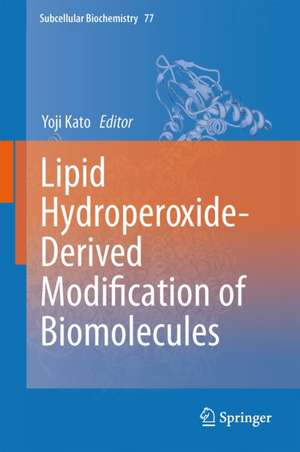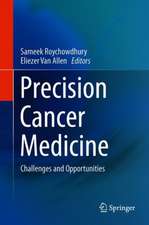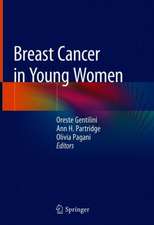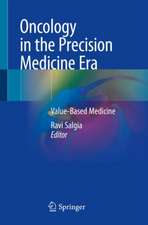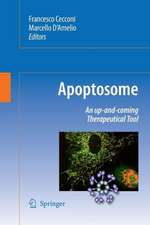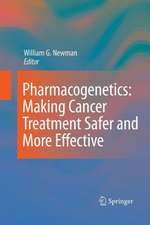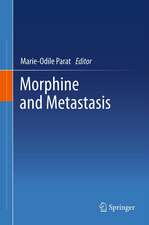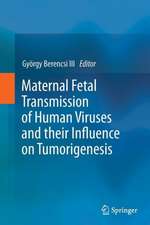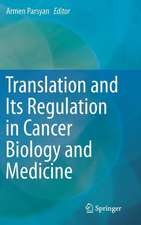Lipid Hydroperoxide-Derived Modification of Biomolecules: Subcellular Biochemistry, cartea 77
Editat de Yoji Katoen Limba Engleză Hardback – 15 ian 2014
| Toate formatele și edițiile | Preț | Express |
|---|---|---|
| Paperback (1) | 711.15 lei 6-8 săpt. | |
| SPRINGER NETHERLANDS – 17 sep 2016 | 711.15 lei 6-8 săpt. | |
| Hardback (1) | 718.10 lei 6-8 săpt. | |
| SPRINGER NETHERLANDS – 15 ian 2014 | 718.10 lei 6-8 săpt. |
Din seria Subcellular Biochemistry
- 18%
 Preț: 948.79 lei
Preț: 948.79 lei - 5%
 Preț: 1456.88 lei
Preț: 1456.88 lei - 18%
 Preț: 1373.84 lei
Preț: 1373.84 lei - 18%
 Preț: 1243.78 lei
Preț: 1243.78 lei - 18%
 Preț: 2098.81 lei
Preț: 2098.81 lei - 18%
 Preț: 1122.10 lei
Preț: 1122.10 lei - 5%
 Preț: 1160.63 lei
Preț: 1160.63 lei - 18%
 Preț: 1396.26 lei
Preț: 1396.26 lei - 18%
 Preț: 1114.96 lei
Preț: 1114.96 lei - 18%
 Preț: 1224.68 lei
Preț: 1224.68 lei - 18%
 Preț: 951.29 lei
Preț: 951.29 lei - 18%
 Preț: 1227.99 lei
Preț: 1227.99 lei -
 Preț: 398.15 lei
Preț: 398.15 lei -
 Preț: 399.88 lei
Preț: 399.88 lei - 18%
 Preț: 1231.47 lei
Preț: 1231.47 lei - 18%
 Preț: 1230.35 lei
Preț: 1230.35 lei -
 Preț: 392.60 lei
Preț: 392.60 lei - 18%
 Preț: 1231.47 lei
Preț: 1231.47 lei - 15%
 Preț: 638.76 lei
Preț: 638.76 lei - 5%
 Preț: 656.26 lei
Preț: 656.26 lei -
 Preț: 389.49 lei
Preț: 389.49 lei - 5%
 Preț: 659.19 lei
Preț: 659.19 lei -
 Preț: 392.37 lei
Preț: 392.37 lei - 5%
 Preț: 662.09 lei
Preț: 662.09 lei -
 Preț: 395.09 lei
Preț: 395.09 lei - 5%
 Preț: 667.99 lei
Preț: 667.99 lei -
 Preț: 400.47 lei
Preț: 400.47 lei - 18%
 Preț: 1224.54 lei
Preț: 1224.54 lei - 15%
 Preț: 647.73 lei
Preț: 647.73 lei - 15%
 Preț: 646.75 lei
Preț: 646.75 lei - 5%
 Preț: 662.30 lei
Preț: 662.30 lei -
 Preț: 395.25 lei
Preț: 395.25 lei - 18%
 Preț: 1230.21 lei
Preț: 1230.21 lei - 18%
 Preț: 1231.95 lei
Preț: 1231.95 lei - 18%
 Preț: 964.54 lei
Preț: 964.54 lei
Preț: 718.10 lei
Preț vechi: 755.88 lei
-5% Nou
Puncte Express: 1077
Preț estimativ în valută:
137.40€ • 143.46$ • 113.72£
137.40€ • 143.46$ • 113.72£
Carte tipărită la comandă
Livrare economică 05-19 aprilie
Preluare comenzi: 021 569.72.76
Specificații
ISBN-13: 9789400779198
ISBN-10: 9400779194
Pagini: 212
Ilustrații: VIII, 202 p. 78 illus., 27 illus. in color.
Dimensiuni: 155 x 235 x 17 mm
Greutate: 0.48 kg
Ediția:2014
Editura: SPRINGER NETHERLANDS
Colecția Springer
Seria Subcellular Biochemistry
Locul publicării:Dordrecht, Netherlands
ISBN-10: 9400779194
Pagini: 212
Ilustrații: VIII, 202 p. 78 illus., 27 illus. in color.
Dimensiuni: 155 x 235 x 17 mm
Greutate: 0.48 kg
Ediția:2014
Editura: SPRINGER NETHERLANDS
Colecția Springer
Seria Subcellular Biochemistry
Locul publicării:Dordrecht, Netherlands
Public țintă
ResearchCuprins
Preface. I Lipid peroxidation and small molecule adducts.- Lipid hydroperoxides as a source of singlet molecular oxygen.- The formation of lipid hydroperoxide-derived amide-type lysine adducts on proteins: a review of current knowledge.- Lipid hydroperoxide-derived adduction to amino-phospholipid in biomembrane.- Amide-type adduct of dopamine - Plausible cause of Parkinson diseases.- Determination of HEL (hexanoyl-lysine adduct): a novel biomarker for omega-6 PUFA oxidation.- Hexanoyl-lysine as a deterioration marker for rice during storage.- Cholesterol hydroperoxides and their degradation mechanism. II Pathophysiological consequences.- Amide-adducts in atherosclerosis.- Oxidative Modification of Lipoproteins.- Immunochemical Detection of Lipid Hydroperoxide- and Aldehyde-Modified Proteins in Diseases.- Role of Lipid Peroxide in the Neurodegenerative Disorders.- Lipid Hydroperoxide-Derived Modification of Proteins in Gastrointestinal Tract. III Applications for diagnosis and development of functional food.- Low-cost and easy-to-use "on-chip ELISA" for developing health-promoting foods.- Hexanoyl-lysine as an oxidative-injured marker - application of development of functional food.- Potential role of oxidative protein modification in energy metabolism in exercise.- Suppressive effects of cacao polyphenols on the development of atherosclerosis in apolipoprotein E-deficient mice.- Index.
Textul de pe ultima copertă
This volume focusses on oxidative modifications of lipid molecules and the successive generation of singlet oxygen. The book also covers the secondary adductions of these reactive species with proteins and aminophospholipids. During lipid peroxidation, the initial event is the formation of lipid hydroperoxide, which is followed by an oxidation event that starts a chain-reaction. The formed lipid hydroperoxide gradually decomposes into harmful aldehydes, which are the advanced end-products of lipid peroxidation. The book consists of three sections:
Part I, entitled Lipid peroxidation and small molecule adducts focusses on the biochemical events that are involved in lipid peroxidation and to the formation of small molecules like singlet molecular oxygen. This part of the book also introduces the hexanoyl-lysine adduct. Part II, entitled Pathophysiological consequences covers a range of damaging physiological consequences of lipid peroxidation, ranging from atherosclerosis to neurodegenerative disorders. Finally, Part III, entitled Applications for diagnosis and development of functional food looks into potential diagnostic uses of lipid peroxidation, the possible beneficial effects that can be achieved and new assays in food safely that have been developed.
Part I, entitled Lipid peroxidation and small molecule adducts focusses on the biochemical events that are involved in lipid peroxidation and to the formation of small molecules like singlet molecular oxygen. This part of the book also introduces the hexanoyl-lysine adduct. Part II, entitled Pathophysiological consequences covers a range of damaging physiological consequences of lipid peroxidation, ranging from atherosclerosis to neurodegenerative disorders. Finally, Part III, entitled Applications for diagnosis and development of functional food looks into potential diagnostic uses of lipid peroxidation, the possible beneficial effects that can be achieved and new assays in food safely that have been developed.
Caracteristici
Provides novel aspects of the nature of lipid hydroperoxides Wide range information from chemistry to pathology related to lipid hydroperoxide Includes methodology of oxidative stress biomarker analyses
